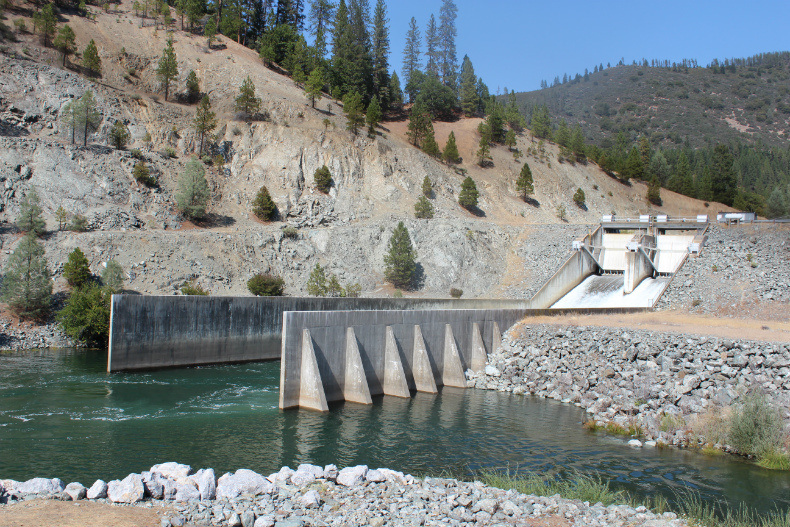
by DGR Colorado Plateau | Aug 28, 2015 | Indigenous Autonomy, Lobbying
By Dan Bacher / Intercontinental Cry
A federal judge on Aug. 26 denied a request by the San Luis Delta Mendota Water Authority and Westlands Water District for a temporary restraining order and preliminary injunction against the higher supplemental flows from Trinity Reservoir being released to stop a fish kill on the lower Klamath River.
The releases that the U.S. Bureau of Reclamation began last week, resulting from requests by the Hoopa Valley and Yurok Tribe fishery scientists to release Trinity River water to stop a fish kill–like that one that killed up to 78,000 adult salmon in September 2002–will continue. The two Tribes, the Pacific Coast Federation of Fisherman’s Associations and the Institute for Fisheries Resources were intervenors for the defendant, Interior Secretary Sally Jewell and the U.S. Department of Interior, in the litigation.

Trinity River below the Lewiston Dam during last year’s supplemental water releases (Photo: Dan Bacher)
In his decision, U.S. District Court Judge Lawrence O’Neill said,
The Court concludes that there is no clear showing of likelihood of success on the merits. Even if Plaintiffs are likely to succeed on the merits of at least one of their claims against Reclamation in connection with the 2015 FARs (Flow Augmentation Releases), the balance of the harms does not warrant an injunction at this time.
“The potential harm to the Plaintiffs from the potential, but far from certain, loss of added water supply in 2015 or 2016 does not outweigh the potentially catastrophic damage that ‘more likely than not’ will occur to this year’s salmon runs in the absence of the 2015 FARs,” ruled O’Neill.
This denial of the request by corporate agribusiness interests to halt badly needed flows for the lower Klamath River is a big victory for the Hoopa Valley Tribe, Yurok Tribe and fishing groups. Both this year and last, Tribal activists held protests demanding the release of Trinity River to stop a fish kill.
Read more at Intercontinental Cry
by DGR Colorado Plateau | Aug 22, 2015 | Colonialism & Conquest, Indigenous Autonomy, Lobbying
Editor’s Note: An original, unabridged version of this article is available at Coal Stop. You can read more and sign up for updates on the proposed Gateway Pacific Terminal at their website.
By Sandy Robson / Intercontinental Cry
United States Senator Steve Daines (R-MT) is on a mission to do whatever it takes to get the Gateway Pacific Terminal (GPT), a 48 million metric-ton-per-year coal export terminal, permitted and built. The GPT project is proposed in Whatcom County, Washington, and would be sited at Xwe’chi’eXen (Cherry Point), along the shoreline, which is part of the Lummi Nation’s traditional fishing area. The company proposing GPT is Pacific International Terminals (PIT), a subsidiary created for the project by SSA Marine.
Tens of thousands of people who steadfastly oppose GPT are standing in the way of Senator Daines, SSA/PIT, and the coal companies like Cloud Peak Energy which have financial interests in seeing that GPT is built and operating. Also standing in the way is the Lummi Indian Tribe, a sovereign nation, standing tall in defense of its treaty rights.
On July 29, Senator Daines’ official website featured a press release about the senator and Congressman Ryan Zinke (R-MT), having led a group of sixteen senators and seventeen members of the House in sending two July 28, 2015 letters (one from the Senate and one from the House) to the U.S. Army Corps of Engineers. The letters urged U.S. Assistant Secretary of the Army Jo-Ellen Darcy, to complete the environmental review process for the proposed GPT project prior to the Corps making a determination whether impacts to any tribes’ U&A (usual and accustomed) treaty fishing rights are more than de minimis, or too trivial to warrant legal review.’
An August 3, 2015 Lummi Nation press release announced that Lummi Indian Business Council (LIBC) Chairman Tim Ballew II sent an August 3 letter to Senator Daines, cc’d to the thirty-two legislators who signed onto those letters, and the Senate Committee on Indian Affairs. In his letter, Ballew reminded them of the U.S. government’s obligation to protect and preserve the Lummi Nation’s treaty fishing rights.
BACKGROUND LEADING UP TO DAINES’ RECENT ACTIONS
In determining whether Lummi Nation’s treaty-guaranteed rights of access to its U&A fishing grounds and stations, and harvest of fish, would be adversely impacted by GPT, the Corps will be applying a de minimis threshold standard. Any impacts considered to be greater than de minimis by the Corps would warrant the GPT permit denial requested by the Lummi Nation.
The fact that the Corps “owes the highest fiduciary duty to protect Indian contract rights as embodied by treaties” is entrenched in case law. That solemn duty and obligation owed to the Lummi Nation by the U.S. federal government is something the agency takes extremely seriously, and addresses separately from any Environmental Impact Statement (EIS) the Corps is tasked with on proposed projects.
Treaty fishing rights of the Lummi are secured to them by the U.S. federal government in the Treaty of Point Elliott of 1855. Article 5 of the Treaty provides that, “The right of taking fish from usual and accustomed grounds and stations is further secured to said Indians in common with all citizens of the Territory. . .”
XWE’CHI’EXEN: WHAT IT MEANS TO THE LUMMI
Lummi Nation’s Sovereignty and Treaty Protection Office Director Jewell James provided some important insight on the significance of Xwe’chi’eXen (Cherry Point) to the Lummi, in the August 2013 issue of Whatcom Watch:
The Lummi have usual and accustomed fishing grounds scattered throughout the San Juan Islands and on the mainland of Whatcom County up to the Canadian border. Not only were our (fishing) village sites located throughout the territory, but the associated burial grounds are located at these sites, as well. Among the most important of these cultural landscapes is Xwe’chi’eXen (Cherry Point).
LIBC Chairman Tim Ballew sent a January 5, 2015 letter to the Army Corps of Engineers, asking the Corps to take action and immediately deny SSA/PIT’s permit application for the proposed GPT project. Ballew wrote:
Review of the impacts associated with this project, including, but not limited to, those analyzed in the Gateway Pacific Terminal Vessell [sic] Traffic and Risk Assessment Study lead to the inescapable conclusion that the proposed project will directly result in a substantial impairment of the treaty rights of the Lummi Nation throughout the Nation’s ‘usual and accustomed’ fishing areas. The Lummi have harvested at this location since time immemorial and plan to continue into the future.
SENATOR ATTEMPTS TO BLOCK ARMY CORPS’ DECISION-MAKING PROCESS
It’s also not surprising that the legislators who signed onto the July 28 letters to the Army Corps, altogether, received over $400,000 in contributions in 2014, from the same GPT-related interests listed above. It’s no surprise that Senator Daines is willing to be Montana coal industry’s point person on the proposed GPT project, because according to opensecrets.org, in 2014, Daines received over $50,000 in total campaign donations from the following contributors connected to the GPT project: Cloud Peak Energy, SSA Marine, FRS Capital Corp. (ultimate parent company of SSA Marine), Peabody Energy, BNSF, Boich Companies (part owner of Global Coal Sales Group, and the National Mining Association (an active advocate for the coal industry).
According to the August 3 Lummi Nation press release previously mentioned in this article, it turns out that the two July 28 letters sent to the Corps by the thirty-two legislators came after three failed attempts by Senator Daines to attach a specifically crafted amendment to various pieces of unrelated legislation. The amendments were designed to try to prohibit the Army Corps from making its determination regarding the Lummi Nation’s treaty fishing rights relating to GPT, before the final EIS would be completed for the project.
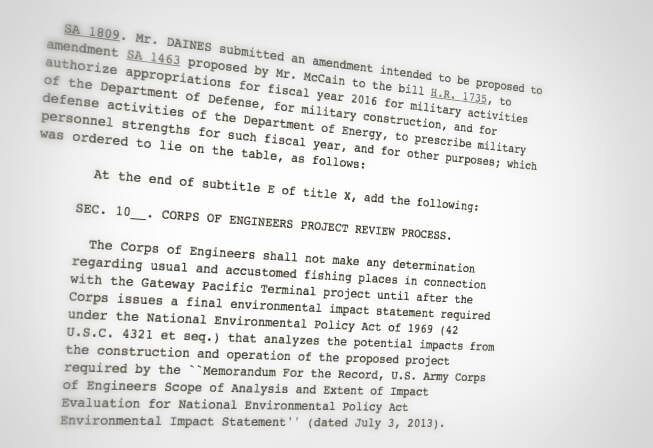
Excerpt of Senate Amendment (S.A.) 1809, proposed by Senator Daines on June 8, 2015
One of those amendments, Senate Amendment (S.A.) 1809, was proposed by Senator Daines on June 8. It was an amendment to Senator John McCain’s (R-AZ) Senate Amendment (SA 1463) attached to a piece of unrelated legislation, the National Defense Authorization Act (H.R. 1735) for fiscal year 2016.
Another example of Senator Daines’ attack on Lummi treaty rights was cited in LIBC Chairman Tim Ballew’s August 3 letter to the senator. His letter included a copy of the language that Daines apparently tried to insert as a proposed amendment to yet another piece of unrelated legislation (H.R. 22). The amendment text was the same language that was proposed in S.A. 1809.An excerpt from S.A. 1809 reads, “The Corps of Engineers shall not make any determination regarding usual and accustomed fishing places in connection with the Gateway Pacific Terminal project until after the Corps issues a final environmental impact statement. . .” S.A. 1809 never received debate as it was withdrawn, so it did not move forward to a vote.
Chairman Ballew admonished Senator Daines in the August 3 Lummi Nation press release:
Senator Daines has repeatedly sought to interfere in the Army Corps’ regulatory review process by seeking to attach legislative amendments to various bills moving through Congress. It’s unconscionable that, as a member of the Senate Indian Affairs Committee, he chooses to ignore treaty rights. He has repeatedly tried to diminish the rights of the Lummi Nation using “middle-of-the-night” stealth legislative tactics that have prevented stakeholders from weighing in.
BURYING AMENDMENTS IN UNRELATED LEGISLATION TO BURY TREATY RIGHTS
Amendments are often attached to unrelated bills, but riders that undermine treaties and sacred sites are particularly egregious. In December 2014, Senator McCain successfully buried an amendment he attached to the 1600-page 2015 National Defense Authorization Act (H.R. 4435). The must-pass NDAA legislation that Congress moves yearly was used as a vehicle by McCain to pass a morally suspect public lands exchange package involving land at Oak Flat, in Eastern Arizona.
Senator McCain’s “midnight” rider which disregards and diminishes treaty rights of the San Carlos Apache and other nearby tribes that he managed to sneak through in 2014, and the repeated legislative attempts by Senator Daines to trample Lummi treaty rights, illustrate the serious harm that can befall the Lummi Nation every single day that passes before the Army Corps makes its determination.
SSA Marine’s vice president Skip Sahlin, sent a May 12, 2015 letter to the Army Corps asking for an extension to respond to the Lummi Nation’s request to the Corps for an immediate denial of the GPT permit application because the terminal would interfere and impinge on the Nation’s treaty-protected fishing rights. In that letter, Sahlin claimed that allowing SSA/PIT the requested additional time “will not harm the Tribe or its treaty rights. . .”
The treaty rights of the Lummi Nation are under attack, and their Nation has had to expend untold efforts to defend those rights secured to them in 1855 by the United States. Every day that passes as the Army Corps is making its decision on the fate of the GPT permit, is another opportunity for coal-backed legislators such as Senator Daines to craft legislation aimed at weakening Lummi Nation’s treaty rights. Reasonable persons would conclude that despite Mr. Sahlin’s claim to the contrary, harm has been done to the Lummi Nation each day that has passed since February 2011, when SSA/PIT first submitted the application for its proposed GPT project to Whatcom County’s planning department.
Chairman Ballew made it clear in his letter to Senator Daines that the Lummi Nation will fight resolutely to defend and protect its treaty rights: “I can assure you, that if the Lummi Nation’s Treaty Fishing Rights are jeopardized by any efforts to allow the project to proceed, we will fight vigorously by all means necessary. In times past, our Nation and its leaders did not have the resources and were unable to stop prior efforts to construct commercial terminals in our region. That day is no more.”
From Intercontinental Cry
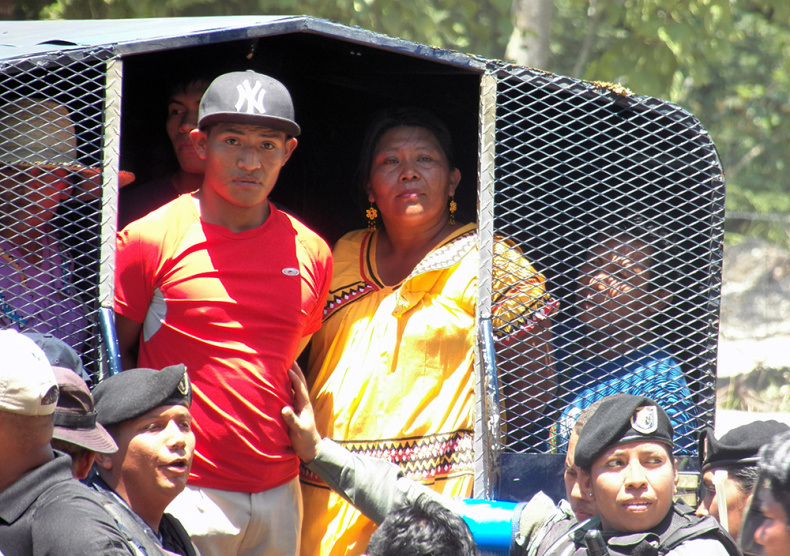
by DGR Colorado Plateau | Aug 6, 2015 | Colonialism & Conquest, Indigenous Autonomy, Obstruction & Occupation
By Richard Arghiris / Intercontinental Cry
Protests against the Barro Blanco hydro dam in western Panama turned violent last Saturday, July 25, when riot police, claiming to act in self-defense, unleashed pepper spray and batons on some 50 Ngäbe activists, women and children among them. At least three protesters were badly injured in the clash.
The crackdown occurred during a visit to the area by the Panamanian Vice President Isabel Saint Malo, who, under the pretext of dialogue, convened three Ngäbe leaders behind closed doors at the Centro Misionero (Mission Centre) in the town of Tolé. Despite a reasonable request to be included in the meeting, leaders from local community groups were excluded. Activists responded to Saint Malo’s move by blockading the Carretera Interamericana, the country’s principle highway.
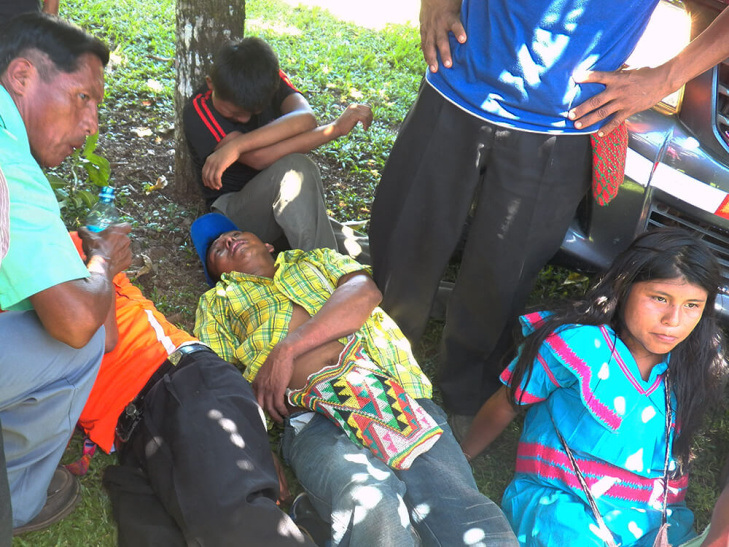
Protesters, including women and children, recover after clashes with the police. (Photo: Oscar Sogandares)
According to the Ngäbe, at around 10:15 am, in scenes reminiscent of the Martinelli years, the police reacted violently to disperse the 50-strong protesters, destroying their equipment, trashing their camps, and burning their banners.
The police deny improper use of force.

Edilma Pinto, 17, suffered a fractured foot during the police crackdown. (Photo: Oscar Sogandares)
Many fled the scene before 20 people were arrested (including several minors) and dispatched to the city of Santiago for processing.
While in the private meeting with Saint Malo, the Cacique of Muná, Chito Gallardo, and the Mayor of Muná, Rolando Carpintero, learned of the arrests and quickly intervened to have them returned. The injured were soon taken to the Casa Misionero for treatment and for the Vice President to bear witness.
According to one person at the scene, the vice president appeared coolly uninterested.
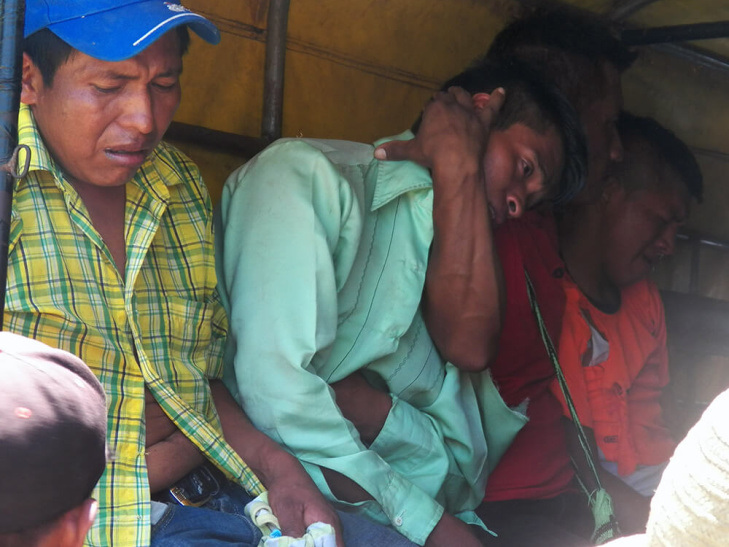
Some 20 Ngäbe protesters were detained by the police. (Photo: Oscar Sogandares)
For several weeks, hundreds of police units have been stationed in and around Tolé, including numerous SENAFRONT troops, an elite militarized squad funded in part by the United States. SENAFRONT is normally charged with defending the jungle frontier with Colombia, making their presence of considerable significance.
Under the US Leahy Law on Human Rights, the US Department of State is prohibited from providing military assistance to foreign units who violate human rights with impunity.
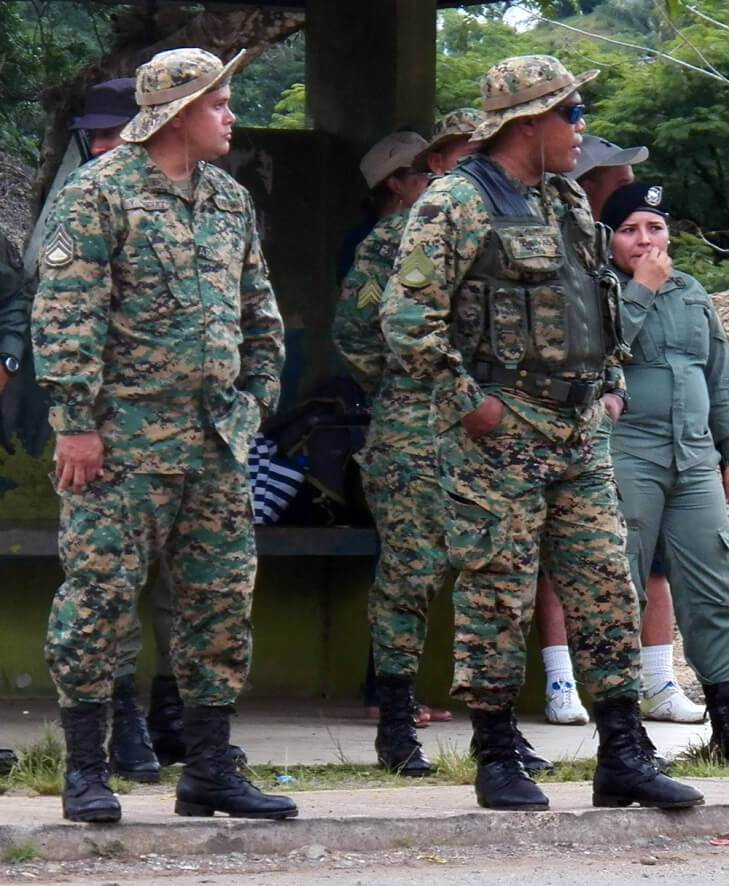
Partly funded by the US State Department, elite SENAFRONT troops have been dispatched to the area. (Photo: Oscar Sogandares)
The clashes on the Interamericana foreshadow greater unrest as Barro Blanco’s owner, Generadora del Istmo (GENISA) – a corporation owned by the controversial Kafie family, now mired in a high-level corruption scandal in Honduras – scrambles to complete the final 5-10% of the hydro dam’s construction.
The company has never sought the free, informed, and prior consent of the indigenous communities living on the banks of the Tabasará river, while the project’s funders, the Dutch and German investment banks FMO and DFE, admit to failing their own due diligence tests. Unfortunately, all funds have now been dispensed to GENISA and the banks themselves made a point of threatening the government when it suspended the project earlier this year.
The negative impacts of Barro Blanco have been identified by scores of technical teams, independent experts, international observers, and the United Nations. Those same impacts are nowhere to be found in GENISA’s Environmental Impact Assessment. Among them, the dam will displace several indigenous and campesino communities, including the community of Kiad, where a unique school and cultural centre is developing the written script of the Ngäbere language.
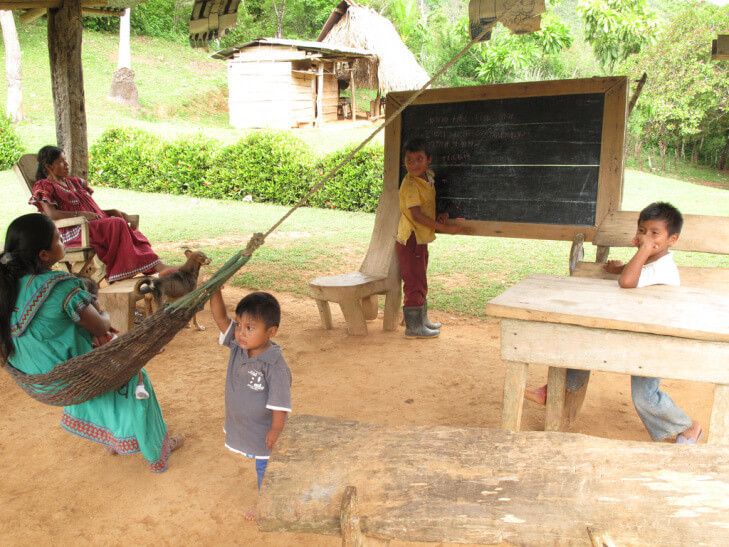
The ancient Ngabere language is taught at this school house in Kiad. (Photo: Richard Arghiris)
Additional impacts include the loss of farm plots and fish stocks — vital sources of sustenance for indigenous and campesino communities in the region – as well as the loss of several ancient petroglyphs, part of Panama’s national patrimony and a special significance to the Mama Tata religion, a Ngäbe revivalist movement that syncretises indigenous animism and Catholicism.
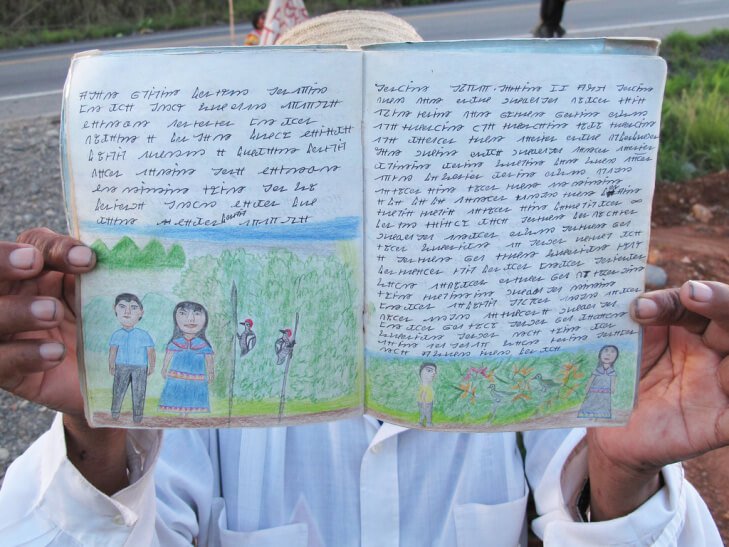
The Ngabere language is a great source of cultural pride. (Photo: Richard Arghiris)
Among the most devout followers of Mama Tata are the M22 resistance movement, who successfully blockaded the entrance to the dam for 38 consecutive days – until just ten days ago. International news footage of the groups praying and dancing on the highway may have influenced the government’s decision to enforce a ‘soft’ take-over of the site entrance. In contrast to the force deployed outside Tolé, Ngäbe women lying in the path of machinery were carefully removed.
Construction of the dam has now resumed and M22 are continuing to pray day and night by the highway. They complain of psychological intimidation with the police shining high intensity lamps on their camp during the night and aggressively entering the temple they have built near the river banks.
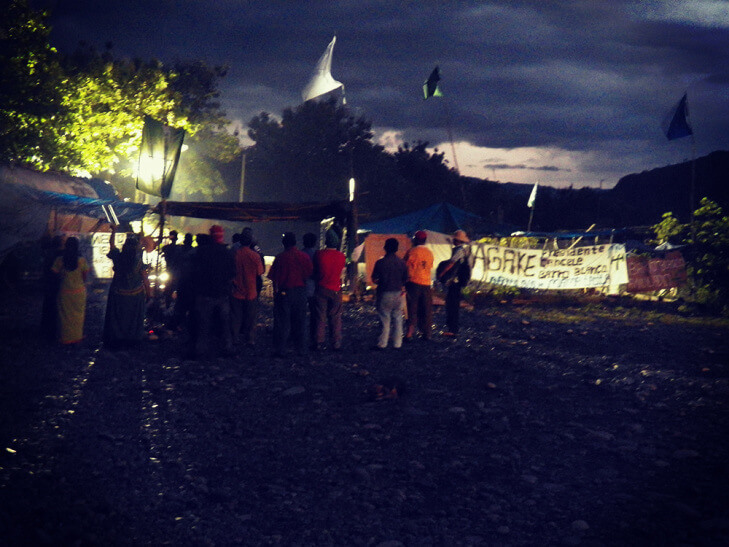
Days before their eviction from the site entrance, M22 gather for prayers under police spotlights. (Photo: Oscar Sogandares)
For his part, Panamanian President Varela, who continues to talk condescendingly about giving the Ngäbe ‘the keys to the dam’ upon its completion, appears to have acquiesced to pressures from his own business community, tacitly enabling foreign corporations who respect neither the environment nor international law nor indigenous or human rights.
The Supreme Court has cheered him on by annulling a moratorium on hydro projects passed by the environment agency, ANAM, who were concerned with the stress being placed on Panama’s delicate but biologically rich watersheds. With the crackdown last week, the Panamanian government appears officially back to business as usual.
From Intercontinental Cry: https://intercontinentalcry.org/barro-blanco-protesters-injured-and-arrested-28467/#imageclose-28472
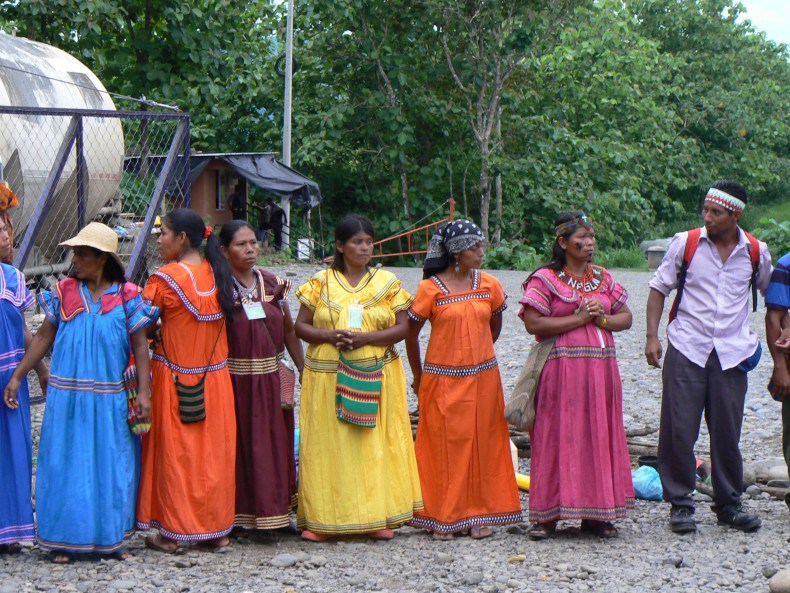
by DGR Colorado Plateau | Aug 5, 2015 | Biodiversity & Habitat Destruction, Colonialism & Conquest, Indigenous Autonomy, Obstruction & Occupation
By Richard Arghiris and Jennifer Kennedy / Intercontinental Cry
June 14, 2015
NGÄBE ISSUE ULTIMATUM TO THE GOVERNMENT OF PANAMA: CANCEL THE PROJECT BY MONDAY
A 30-strong splinter group of Ngäbe from the M10 resistance movement has blocked the entrance to the Barro Blanco hydroelectric dam in western Panama, preventing workers from entering the site. The 15 year struggle of the Tabasará river communities to protect their livelihoods, their culture, and their ancestral heritage now appears to be entering a tense new phase. With negotiations exhausted and the dam 95% complete, M10 has an issued an ultimatum for the government to cancel the project by Monday, June 15, 2015. It is unclear how the government will respond.
“Being Ngäbe-Buglé cultural patrimony,” said Clementina Pérez, part of the group camped at Barro Blanco’s gates. “Our river, our mother earth, our ecology, our existence, we are here to make known to the national and international community that this patrimony belongs to us and to the church of Mama Tata. With the conservation of peace, liberty, justice and unity, liberation and social justice… [we ask] the President of the Republic the cancellation and removal of the dam from our communities, our river and our mother earth, which belong to us as original people of the Americas…”
Funded by European banks – the German Investment Corporation (DEG) and the Dutch Development Bank (FMO) – the dam is set to inundate a string of Ngäbe and campesino communities, all of whom have voiced their objections from the outset. The flood will destroy ancestral petroglyphs, fertile agricultural grounds, and Mama Tata cultural centres, including a unique school where the emerging written script of the Ngäbere language is being developed and disseminated. The dam will significantly impact the river’s marine life, wiping out migratory fish species which many communities – both up and down stream – rely upon for essential protein. None of the Tabasará communities have provided their free, informed and prior consent to the dam, a fact recently confirmed by the FMO’s own independent complaints mechanism (ICM).
“Lenders should have sought greater clarity on whether there was consent to the project from the appropriate indigenous authorities prior to project approval,” said an ICM report, published on May 29, 2015. “[The plan] contains no provision on land acquisition and resettlement and nothing on biodiversity and natural resources management. Neither does it contain any reference to issues related to cultural heritage…”
The report is the latest in a series of professional analyses that pour a thick layer of scorn over the dam project’s owner, Generadora del Istmo (GENISA). Demonstrably unlawful, GENISA has been condemned by numerous independent investigators, the United Nations, several international NGOs, and Panama’s own environmental agency, ANAM, who found a raft of flaws and short-comings in their environmental impact assessment.
But despite failing their own due diligence, the banks appear to have shrugged off the ICM report with an insipid call for “constructive dialogue” and “a solution for a way forward.” In February this year, the FMO chose to threaten the government of Panama after building work was temporarily suspended on the recommendation of ANAM. Writing to the Vice President, the FMO warned that the suspension “May weigh upon future investment decisions, and harm the flow of long-term investments into Panama.”
The government seems to have taken this threat to heart. Panama’s president, Juan Carlos Varela, who was elected to office in 2014, flip-flopped on Barro Blanco before finally falling in line. Last week, while proffering flimsy reassurances about having found a human rights solution, his government left the negotiating table and signaled an end to the suspension of works. M10 claims the work never stopped and has been continuing clandestinely. They are now mobilizing for action.
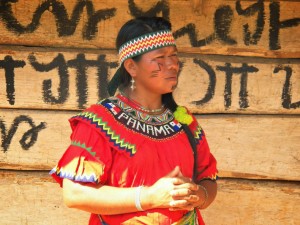
Clementina Perez (Photo: Oscar Sogandares)
“If this situation is not resolved,” said Clementina Pérez, “We will go to the Panamerican highway to ask together, at a national level, the cancellation of Barro Blanco…”
Rising with stark grey walls above the denuded banks of the Tabasará, Barro Blanco has become a symbol of the previous administration, its fundamental violence and contempt for the rule of law. The former President Ricardo Martinelli – now on the run in the United States and facing a corruption probe back home – provoked no less than four major uprisings as he grasped for land and resources in Panama’s indigenous territories. Heavy-handed repression resulted in the deaths of several protesters and bystanders, including an unarmed teenage boy who was shot in the face by police. Barro Blanco is the visible legacy of a proudly thuggish President who serially abused Panama’s Indigenous Peoples and plundered the country at will. Thus far, Varela has been keen to strike a more decent and humane tone. How he now handles the crisis evolving on the banks of the Tabasará River will be a demonstration of his sincerity, or lack of.
From Intercontinental Cry: https://intercontinentalcry.org/ngabe-block-entry-to-barro-blanco-hydro-dam-panama-28186/
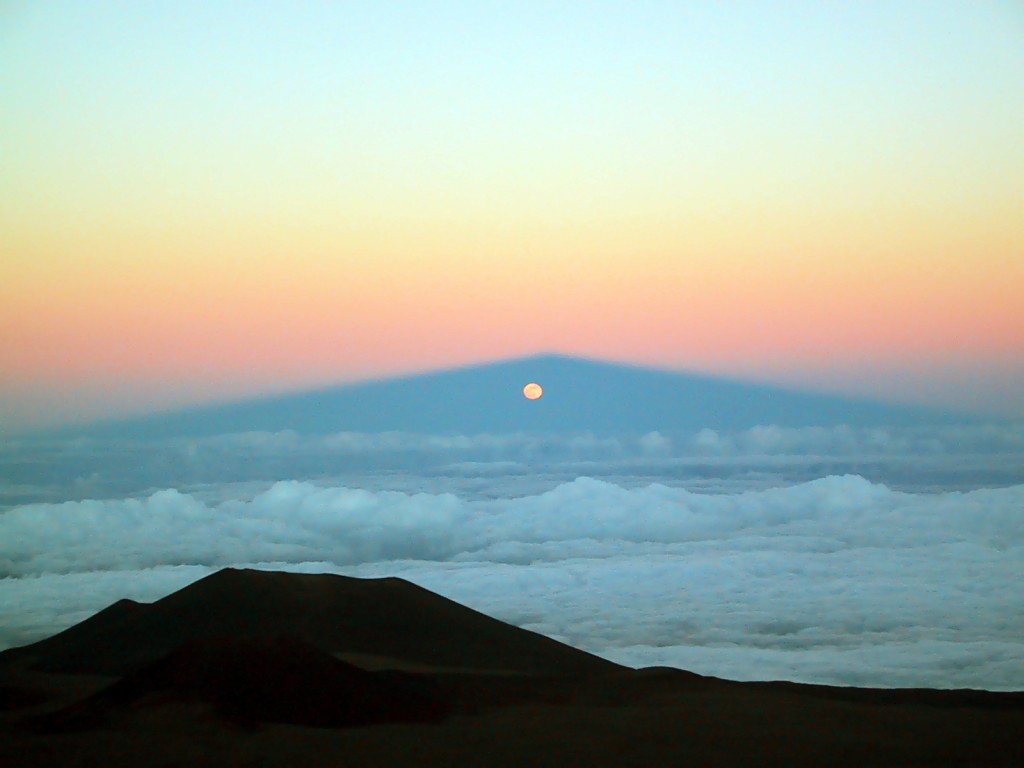
by Deep Green Resistance News Service | May 22, 2015 | Indigenous Autonomy, Listening to the Land
By Will Falk / Deep Green Resistance
Looking up at the still, lingering morning stars from the best stargazing location in the world early on the third day since my arrival at the occupation on Mauna Kea, my personal velocities catch up with me and I listen. I stand at 9,200 feet above sea level. North and above me, Mauna Kea’s shoulders broaden as they rise into the heavens. Down and to the east, a thick cover of clouds hides the valley below and deadens the rattle of rifle fire coming from the US military training center on the Mountain. Wind scatters the volcanic dust at my feet.
I have never been to a place like this, never looked down on the clouds from any where other than a plane seat, never marveled at the feel of lava pebbles in my palm and I wonder what it all means. Dawn’s thin air only offers my own reflections back to me.
I’ve been on the road for over a year now and the traveling leaves me feeling dizzy. After two suicide attempts, I decided to take tangible steps to alleviate my despair. A great part of my despair stemmed from the realization that life on Earth is running out of time. Even mainstream scientists are seriously questioning the ability of the human race to make it through the next half-century. Part of this destruction is rooted in the way the dominant culture has strayed too far from land-based, traditional knowledges. Traditional knowledges are often rooted in stories based on the land. So, one way to understand the destruction is to see how the dominant culture has forgotten the original stories the land is telling us.
My path out of despair has lead me all over this side of the world from the Unist’ot’en Camp on Wet’suwet’en territory in northern so-called British Columbia to Kumeyaay territory in so-called San Diego all the way across the ocean here to Hawai’i and Mauna Kea.
Moving at this pace, I sometimes feel profoundly lonely. Each new place means leaving friends behind and entering a social environment where no one knows who I am. My friends and family are scattered across North America. When I’d rather see my friends smile in person and hear their laughter transported over a breeze instead of the internet, I feel a deep sorrow. I know it is a self-imposed exile, but still, I yearn for home.
“Home” is something I do not have time for. The world is burning – our home is burning – and before I can rest comfortably in my home, I need to work to make sure that home does not burn down. Writing seems to be my talent, so I come to Mauna Kea persisting in my rejection of home, and offer up my pen.
Sitting down to write these first few days on Mauna Kea, to engage in the support I’ve promised, I’ve found that my migrations have an even deeper side effect: I struggle to relate to the places I’m in. New slants of sunshine are disorienting. New smells from a strange wind confuse me. I do not know the names of the birds I hear singing or the names of the trees who give me shade.
Writing is a spiritual practice for me that involves listening for the voices I know are speaking from the natural places I’m in. I’m finding it hard to understand what I am hearing here because I have not had enough time to develop relationships with the non-human beings living here on the Mountain. I have not heard enough of Hawaii’s history. I do not have the experiential referents to hear a story. I keep stumbling on the thought that I cannot possibly do this place justice in three days. Hawaiians have lived with Mauna Kea for time immemorial and already know what these other beings are saying.
Each time I try to describe a hill I’m looking at, the sound the sparse mountain trees make in the evening breeze, or the sight of the thin, new moon hanging low in the sky outside our tent, I sense much deeper stories at work. I feel incapable, unprepared, lost. I am not just seeing, hearing, and feeling these forces on a physical level. I sense these forces are working on a level deeper than I have the language to express.
How can I possibly write something comparable to the stories and wisdoms developed over millennia of listening by the original peoples who live here? Is English – a language developed in a land thousands of miles away – even adequate to the task? Or, am I struggling to articulate what I’m hearing because those voices are properly described in the Hawaiian language?
***
In these first three days, I have been showered in Hawaiian hospitality and my loneliness is alleviated. At the occupation, kapu aloha is thriving. I’ve spent most of my time “talking story” and I’ve learned just how potent Hawaiian traditional knowledges are. “Talking story” is a Hawaiian term meaning something similar to, but more than “chit-chat,” closer to “getting to know each other,” or “craic” in my own Irish tradition. Through talking story with the protectors here, I’ve heard about everything from the strategic military prowess of King Kamehameha I to the genius traditional navigational techniques of Hawaiian sailors to the high percentage of NFL players that come from Hawai’i.
Most importantly, though, I’ve been receiving an education in Hawaiian spirituality. I will not and cannot claim to know or understand very much of what has been shared with me. I’ve heard about the physical forms Hawaiian deities take – forms like snow, thunder, mist, and bamboo.
I’ve heard about Mauna Kea existing in both realms of the land and the sky and how traditionally humans were not supposed to travel very far up Mauna Kea. My experiences with death cause me to state that my favorite thing I’ve learned about Hawaiian spirituality, so far, is that every being that gives and facilitates life is a god revered for its role in supporting life.
Looking around me with my vision enhanced from the Mauna, I ponder life. The shallowness of my breath on the Mountain reminds me of those last moments before I lost consciousness each time I tried to kill myself. Both times I laid in what I thought would be my deathbed I was confronted with the shame knowing that suicide would prevent me forever from standing on the side of the living. Both times I saw the story of my life stretch out before me and knew I wanted the story to go on.
***
Last night while I was pondering my inability to write anything of substance, I experienced a series of significant events. First, while a few of us sat around talking story, the conversation turned to the Thirty Meter Telescope project. Stopping this project is, of course, why we’re here.
Many of the occupiers here are my age – I am 28 – and interestingly several of them were educated in Hawai’i’s first Hawaiian language immersion program. One of those who graduated from this program is a man named Kahookahi Kanuha, and I’ve heard him call the movement to protect Mauna Kea the most powerful Hawaiian movement since the resistance to American occupation in the 1890s. One of the reasons for the power of this movement, he explained, is that Hawaiians are getting their language back.
This fits what I understand about history. In my own Irish tradition, for example, the path to independence included a strong Gaelic language revival in the late 1890s with artists like William Butler Yeats and Lady Gregory creating new, specifically Gaelic works, with Gaelic language schools springing up around the nation, and a new academic interest in what had been an illegal language.
I know, too, that one of the first things colonizers do is work to erase the colonized’s language.
This happened in Hawai’i in 1896 when the illegal Republic of Hawai’i forbade the use of the Hawaiian language in schools. Indigenous languages are so important to decolonization because as Haunani-Kay Trask writes in her diagnosis of colonization in Hawai’i, “From a Native Daughter,” “Thinking in one’s own cultural referents leads to conceptualizing in one’s own world view, which, in turn, leads to disagreement with and eventual opposition to the dominant ideology.”
Later that night, after I heard Kahookahi explain that the Hawaiian language revival is empowering his people, the director of Hawai’i’s Department of Land and Natural Resources (DLNR) stopped by to talk story with the Mauna Kea protectors. In many respects, the DLNR’s interests are opposed to the Mauna Kea’s protectors, but he was invited in a spirit of dialogue and respect, and to his credit he visited (and brought us desert). During the course of the conversation, the director said, “There is fear in misunderstanding. And when you learn to understand, you learn not to fear.”
***
I am writing this Protecting Mauna Kea series, in part, to understand how it is possible for a culture to think it is acceptable to desecrate another people’s most sacred site by building a massive telescope on the top of a beautiful mountain. I want to understand what the individual humans responsible for this project think and feel. Are they simply mistaken about the nature of physical reality? Do they really think that digging deeply into a mountain to build a telescope will be harmless? What I have learned, so far on the Mountain, from the protectors, from Kahookahi, and from the director of the DLNR provide, perhaps, an answer.
Quite simply, when you understand a place is full of stories and the beings who provide these living stories, it becomes very difficult for you to destroy those stories. When you understand the language of a place and learn how to communicate in that place, it becomes very difficult for you to destroy that place. When you learn to talk story wherever you are, you can learn to understand, and fear becomes more difficult.
I think the TMT project is the result of a culture that has forgotten how to talk story, has forgotten the living stories unfolding everywhere around us. When you look at Mauna Kea and see a simple mountain – just a collection of earth as I’ve heard some insensitive folks describe it-you will treat it one way, but when you look at Mauna Kea and see, as traditional Hawaiians do, a vast collection of stories and living story-givers, you will treat it in a much different way.
Maybe the TMT project is a symptom of a culture moving too fast, governments spreading too far from the lands that created them, and peoples alienated from the homes of their ancestors?
Maybe the dominant culture is caught in the same problems I face in my travels? Moving with too high a velocity, it is confused, it is lonely, and instead of talking story with Mauna Kea, it seeks answers in the stars.
I have taken a great amount of comfort in the willingness of the Mauna Kea protectors to talk story with me. I am beginning to feel like I am making good friends. They are quick with inclusive stories and jokes. They are sharing the stories of Mauna Kea and my loneliness subsides.
All credit for this is due to the Mauna Kea Protectors.
I believe those controlling the TMT project have lost their stories and suffer a deep trauma because of this. They have forgotten that the land is the source of all meaning and feel justified destroying the land to build an attempt to find meaning on other planets. I think they would do well to truly talk story from a position of respect with the Mauna Kea Protectors. You never know what you’ll learn.
From San Diego Free Press
Find an index of Will Falk’s “Protecting Mauna Kea” essays, plus other resources, at:
Deep Green Resistance Hawai’i: Protect Mauna Kea from the Thirty Meter Telescope
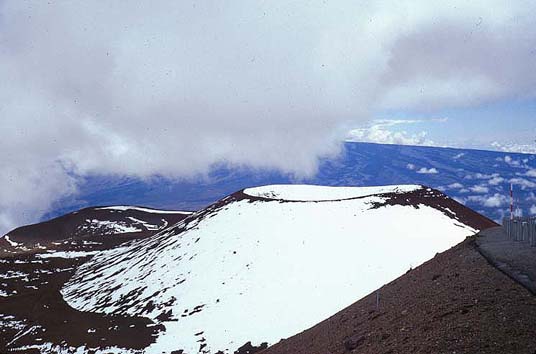
by Deep Green Resistance News Service | May 5, 2015 | Indigenous Autonomy
By Will Falk / Deep Green Resistance
When people have asked me why I am going to Hawai’i to help protect Mauna Kea and my answer involves words like “sacredness” or “spiritual,” I am surprised whenever I see the grimaces.
I often get an explanation like this, “I support indigenous people, of course, but the telescope is for science. Isn’t it a little…superstitious to block an astronomy project for a mountain?” I said I was surprised, but I shouldn’t be. Spirituality, I forgot, is anathema in many leftist circles.
It shouldn’t be.
I understand that many in this culture have been wounded by their experiences with religion. Some religions have, on the whole, been disasters for the living world. But, to write off all spirituality because of the actions of a few religions, is not just intellectually lazy and historically inaccurate, it erases the majority of human cultures that lived as true members acting in mutual relationship with their natural communities.
I am writing this article from occupied Ohlone territory in what is now called San Ramon, CA (in the Bay Area). According to the first European explorers who arrived here, this place was a paradise.
A French sea captain, la Perouse, wrote, for example, “There is not any country in the world which more abounds in fish and game of every description.” Flocks of geese, ducks, and other seabirds were so numerous that a gun shot would cause the birds to rise, “in a dense cloud with noise like that of a hurricane.”
In 250 years, with the arrival of Europeans and their spiritualities, we have gone from flocks of birds making noises like a hurricane to the concrete jungles many of us call “home.”
What was it about the Ohlone people that caused them to live in such balance with their natural community? Why didn’t the Ohlone people exhaust their land bases, over shoot the carrying capacity of their home, and colonize other lands like the Europeans who came with their crosses held high forcing the Ohlone to work and to die in the Missions? Only a racist could say, “Because they weren’t smart enough.”
Let me suggest that it was the Ohlone spirituality, the Ohlone way of relating to the world, that caused them to live the way they did. Of course, the Ohlone are just one of thousands of indigenous examples.
Right now, with the world on the verge of total collapse, wouldn’t we do well to respect the wisdoms developed by indigenous peoples who lived in balance with their land bases for thousands of years?
***
Those attempting to force the TMT project on Mauna Kea are products of a culture that has committed spiritual suicide. The dominant culture committed spiritual suicide when it adopted the belief that the land – as the physical source of all life – is not sacred.
Now, it attempts real suicide. I know because I did it, too. Twice.
The path to suicide begins with lies – lies like the notion that a mountain like Mauna Kea does not and cannot speak. As Derrick Jensen points out in A Language Older Than Words, the first thing they do in vivisection labs is cut the vocal cords of the animals they’re going to torture so they don’t have to hear the animals’ screams.
Now the dominant culture is cutting the vocal cords of the entire planet. Women are objectified so they may be raped, indigenous peoples are called savages so they may be massacred, and mountains are described as piles of matter so their tops may be chopped off, their guts ripped out in open pit mines, and massive telescopes built on their peaks.
The Sioux lawyer and author, Vine Deloria Jr., in his work God is Red, diagnosed our current environmental disaster as essentially a spiritual failure.
For Deloria, the Western notion that spirituality can be transported across space, time, and cultural context is a lie and leads to the spiritual emptiness that European settlers on this continent display.
Even worse, though, dominant Western spiritualities like Christianity demand that believers place their faith in a God existing somehow above and beyond the real, physical world. Instead of a belief in the land as the source of all life, an abstract, jealous, invisible, and largely incomprehensible male deity becomes the source of all life.
A hierarchy of beings is established with God on top, followed by angels, humans, animals comparable to humans evolutionarily, all the way down to plants, insect, and microbes. Mountains like Mauna Kea, in this view, are simple heaps of dirt. They may be pretty to look at, but nothing more.
My personal path to suicide reflects the cultural path to suicide Jensen and Deloria describe.
My family is devoutly Catholic. Before I turned 18 and left home, I can count the number of times I missed Mass on one hand. One of my grandmother’s favorite Christmas gifts was handmade, specially blessed rosaries. She says the rosary every morning. Scapulars hang from the rearview mirrors of cars family members drive. Of course, every doorway contains artistic renditions of Christ’s crucifixion.
I remember sometime in my early teens standing beneath a particularly brutal crucifix when I recognized the spiritual emptiness surrounding me. I looked at the crown of thorns piercing Christ’s forehead. I watched the blood running into his eyes. I winced at the spikes driven through his hands and feet. I knew that Christ’s femurs were broken by soldiers – mercifully, perhaps – so he could not use his legs to push up, open his lungs, and draw breath. I grew nauseous imagining Doubtful Thomas digging his hands into the lance wound under Christ’s rib cage.
Educated in Catholic grade schools, I knew the various explanations for Christ’s terrible death. He died to fulfill Old Testament prophesies. He died to redeem humanity. He died because he brought a revolutionary message of humility, poverty, and love. He died because he challenged the power of his Roman and Jewish rulers. He died, simply, to save the world.
I began to think about the spiritual practices in the Catholics I knew. I didn’t know anyone who was giving up much more than a percentage of their income to the Church much less putting their lives in danger to save the world.
When I asked myself how so many people could insist that Catholicism was the one, true faith while no one was willing to walk the same paths as Christ, the first cracks appeared in the wall of denial I called “faith.” Simply put, I looked around and couldn’t find any Christs.
As I grew up, the wall crumbled. The first time I masturbated I was convinced the Virgin Mary would appear to haunt me. The day after I lost my virginity, I went to Mass expecting to feel God biting me with guilt. All I could feel was joy that I could share such a wonderful feeling with a lover. I finally allowed myself to accept my disbelief and started asking questions. How could people professing love for the world propagate a message rooted in guilt, self-denial, and shame?
I became angry. I felt completely betrayed. I saw a world filled with spiritually dead people. The only people I knew speaking about spirituality were liars. So, I took my anger too far and decided that spirituality itself must be dead.
Giving up on spirituality, the world became a dead zone filled simply with material. Yes, I worked to ease human suffering. But, I only did this out of a strange sense of duty, out of the remnants of Catholic guilt that seeped so thoroughly into my soul that I knew no other way to function.
I hung on to this perspective for a few years, denying the voices singing around me, and essentially strangling my own spirituality to death. The dominant culture is cutting vocal cords and I stuffed my ears with despair. Perhaps, it was only logical – committing spiritual suicide as I did – that physical suicide came next.
***
The TMT project on Mauna Kea and others like it around the world are expressions of a culture determined to commit suicide. And I’m not talking about a metaphoric, cultural suicide. I’m talking real, physical suicide. I’m talking about the destruction of the planet’s life support systems.
How else do you explain storing a 5,000 gallon hazardous chemical waste container above the largest freshwater aquifer on Hawai’i Island like the TMT builders want to do?
To stop the TMT project, to stop the genocide of indigenous peoples, and to save the world, I believe we need to empower spiritualities that learned how to live in balance with their land bases. We need to empower indigenous spiritualities around the world.
Our predicament today is even more dire than in 1973 when Deloria wrote in God Is Red, “Ecologists project a world crisis of severe intensity within our lifetime…It is becoming increasingly apparent that we shall not have the benefits of this world for much longer. The imminent and expected destruction of the life cycle of world ecology can be prevented by a radical shift in outlook from our present naive conception of this world as a testing ground of abstract morality to a more mature view of the universe as a comprehensive matrix of life forms. Making this shift in viewpoint is essentially religious, not economic or political.”
I need to be absolutely clear before I write on: Personal spiritual transformation is not going to save us from anything, but our own personal despair. What we need are spiritual transformations on the cultural scale, but we’re not going to achieve these transformations when too many insist that spirituality is worthless.
Just like we will not recycle our way to the revolution, successfully petition Shell to stop murdering the Niger River Delta, or write a persuasive enough essay to convince those in power to stop the TMT project, personal spiritual transformation is too often a distraction from the need for physical action in the physical world.
I’ve written that no emotion – including despair – can kill you. You can kill you. You can put a gun to your temple, snort up a bottle of pills, or run the exhaust into your sealed-off car, and kill yourself. But, in each instance it will not be an emotional or a spiritual state that will kill you. It will be a physical action that kills you. This also means that it will take physical actions to bring you out of despair. This is as true on the cultural level as it is on the personal.
The dominant culture suffers from a profound sense of despair. It says that destruction is human nature. It says that greed is universal. It says that we already live in the best possible world and this world is violent, evil, and hateful. It would be one thing if the dominant culture was content to hold this despair in its heart, content to stay in bed all day with the paralyzing despair that many of us have felt.
The problem for life on this planet – the problem at Mauna Kea – is the dominant culture manifests its despair physically. Once the dominant culture isolated itself from the rest of life, it grew resentful. It became angry. And now it seeks a murder suicide. Left unchecked, it will kill everything and then turn the gun on itself.
In order to turn the spiritual tide we must protect places like Mauna Kea. If we lose the sacred, we won’t be far behind.
From San Diego Free Press
Find an index of Will Falk’s “Protecting Mauna Kea” essays, plus other resources, at:
Deep Green Resistance Hawai’i: Protect Mauna Kea from the Thirty Meter Telescope















